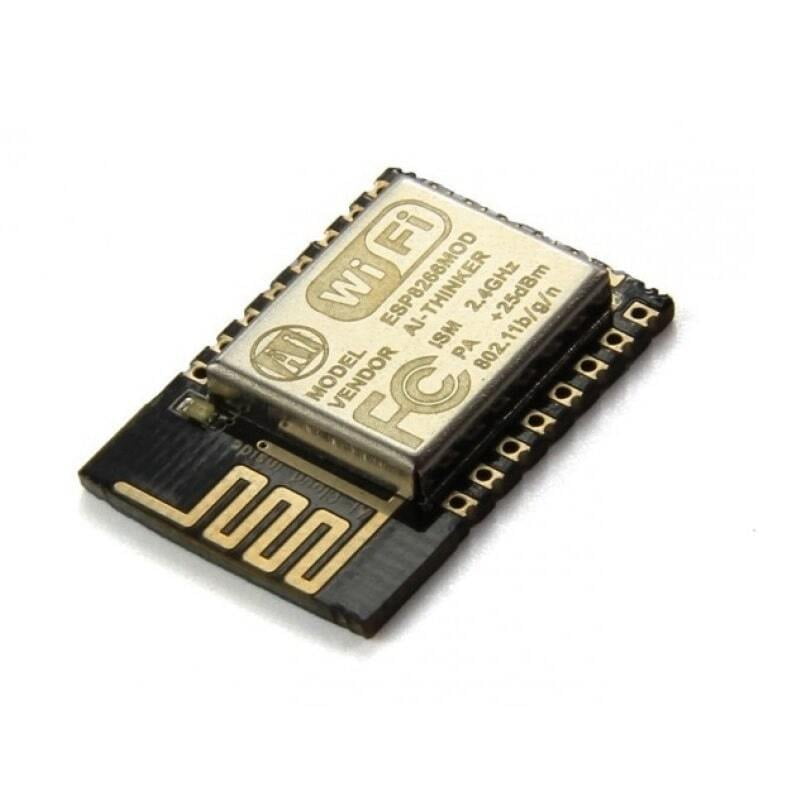The ESP8266 ESP-12E is a powerful, compact Wi-Fi module that has revolutionized the world of IoT (Internet of Things). With its affordable price, robust performance, and wide range of applications, this module has become a favorite among developers, hobbyists, and engineers. In this blog post, we’ll explore the features of the ESP-12E, its applications, and how to start using it in your IoT projects.
What is the ESP8266 ESP-12E?
The ESP8266 ESP-12E is an advanced version of the ESP-12 module. It is a highly integrated Wi-Fi module built around the ESP8266 chip by Espressif Systems. It combines Wi-Fi connectivity, a microcontroller, and ample GPIO pins in a small footprint, making it ideal for wireless IoT applications.
The ESP-12E includes an onboard antenna, flash memory, and additional pins compared to its predecessor, offering enhanced flexibility and functionality.
Key Features of the ESP8266 ESP-12E
Processor and Memory:
Powered by a 32-bit Tensilica L106 processor running at 80 MHz (can be overclocked to 160 MHz).
4 MB of flash memory for storing programs and data.
Wi-Fi Connectivity:
Supports IEEE 802.11 b/g/n Wi-Fi standards.
Offers SoftAP and Station modes, allowing it to act as both a client and an access point.
Integrated TCP/IP stack for seamless internet communication.
GPIO Pins:
Provides 11 GPIO pins for connecting sensors, actuators, and other peripherals.
Includes ADC (Analog-to-Digital Converter) and PWM (Pulse Width Modulation) capabilities.
Communication Protocols:
Supports UART, SPI, and I2C for interfacing with other devices.
Low Power Consumption:
Features deep-sleep modes to conserve power, making it ideal for battery-operated projects.
Built-in Security:
Includes SSL/TLS support for secure communication over the internet.
Compact Size:
Dimensions of approximately 24 mm x 16 mm, making it suitable for space-constrained designs.
Applications of the ESP8266 ESP-12E
The ESP-12E module is used across a diverse range of applications due to its versatility and connectivity options:
- Home Automation
Control lights, fans, and other appliances remotely.
Integrate with voice assistants like Alexa or Google Home.
- Smart Agriculture
Monitor soil moisture, temperature, and humidity in real time.
Automate irrigation systems based on environmental conditions.
- Industrial IoT (IIoT)
Enable predictive maintenance of machinery by monitoring operational parameters.
Collect and transmit data to cloud platforms for analytics.
- Wearable Devices
Integrate into health-monitoring systems like fitness trackers or heart rate monitors.
- Educational Projects
Ideal for students and hobbyists to learn IoT concepts and build prototypes.
- Weather Monitoring Systems
Gather data from sensors and upload it to cloud services for visualization and analysis.
How to Get Started with the ESP8266 ESP-12E
- Hardware Requirements:
ESP8266 ESP-12E module.
USB-to-Serial converter (e.g., FTDI adapter).
Breadboard and jumper wires.
Power supply (3.3V regulated).
- Setting Up the Development Environment:
Install the Arduino IDE or NodeMCU firmware for programming.
Add the ESP8266 board package to the Arduino IDE:
Install the “ESP8266” board package.
- Connecting the Module:
Wire the ESP-12E to the USB-to-Serial converter:
Connect VCC to 3.3V.
GND to ground.
TX to RX of the converter.
RX to TX of the converter.
Pull CH_PD (Chip Enable) high (connect to 3.3V).
- Uploading Code:
Select “Generic ESP8266 Module” from the Tools > Board menu in the Arduino IDE.
Write or load example code, such as a basic Wi-Fi connectivity sketch, and upload it to the module.
- Testing the Setup:
Open the serial monitor to view debug information or test responses from the module.
Connect the ESP-12E to a Wi-Fi network and verify its functionality.
Advantages of Using ESP8266 ESP-12E
Affordable and Accessible:
Offers high performance at a fraction of the cost of other Wi-Fi solutions.
Large Community Support:
Backed by a vast online community providing libraries, tutorials, and troubleshooting tips.
Versatility:
Suitable for a wide range of applications, from DIY projects to industrial systems.
Compact Design:
Fits easily into small enclosures or wearable devices.
Challenges and Considerations
Power Supply Requirements:
The ESP-12E is sensitive to power fluctuations; ensure a stable 3.3V power supply.
Limited GPIO Pins:
While sufficient for many projects, complex designs may require additional GPIO expanders.
Heat Generation:
Prolonged operation at high loads can cause heat buildup; consider adequate ventilation.
Conclusion
The ESP8266 ESP-12E is a game-changer for IoT development. Its combination of Wi-Fi connectivity, processing power, and ease of use makes it ideal for both beginners and experienced developers. Whether you’re building a smart home system, prototyping an IoT device, or diving into industrial applications, the ESP-12E is an excellent choice to bring your ideas to life.
By understanding its features and applications, you can unlock the full potential of this versatile module and take your projects to the next level. Start experimenting with the ESP-12E today and explore the endless possibilities it offers in the world of connected devices.





